An Experimental Study on Performance Evaluation of Shading Matrix to Select Optimal Parking Space for Solar-Powered Electric Vehicles
Abstract
:1. Introduction
2. Study Area
3. Experimental Methods
3.1. Experimental Equipment
3.2. Experimental Settings
4. Results
5. Discussion
5.1. Additional Findings from Experiment Results
5.2. Selecting an Optimal Parking Space for SPEVs
5.3. Advantages and Disadvantages of Shading Matrix Generation Using the Hemispherical Image
6. Conclusions
Author Contributions
Funding
Informed Consent Statement
Conflicts of Interest
References
- United Nations. The Paris Agreement. Available online: https://unfccc.int/process-and-meetings/the-paris-agreement/the-paris-agreement (accessed on 7 November 2022).
- United Nations. Adoption of the Paris Agreement. Available online: https://unfccc.int/files/essential_background/convention/application/pdf/english_paris_agreement.pdf (accessed on 7 November 2022).
- Intergovernmental Panel on Climate Change (IPCC). Global Warming of 1.5 °C Special Report. Available online: https://www.ipcc.ch/sr15 (accessed on 7 November 2022).
- International Energy Agency (IEA). Net Zero Emissions by 2050 Scenario (NZE). Available online: https://www.iea.org/reports/world-energy-model/net-zero-emissions-by-2050-scenario-nze (accessed on 7 November 2022).
- Intergovernmental Panel on Climate Change (IPCC). Climate Change 2022 Mitigation of Climate Change. Available online: https://report.ipcc.ch/ar6wg3/pdf/IPCC_AR6_WGIII_FinalDraft_FullReport.pdf (accessed on 7 November 2022).
- World Economic Forum (WEF). Circular Economy Is Key to Accelerating Net-Zero Transportation. Here’s Now. Available online: https://www.weforum.org/agenda/2022/05/circular-economy-net-zero-transportation (accessed on 7 November 2022).
- International Energy Agency (IEA). Net Zero by 2050 A Roadmap for the Global Energy Sector. Available online: https://iea.blob.core.windows.net/assets/deebef5d-0c34-4539-9d0c-10b13d840027/NetZeroby2050-ARoadmapfortheGlobalEnergySector_CORR.pdf (accessed on 7 November 2022).
- National Highway Traffic Safety Administration. Corporate Average Fuel Economy. Available online: https://www.nhtsa.gov/laws-regulations/corporate-average-fuel-economy (accessed on 7 November 2022).
- The White House. FACT SHEET: The Biden-Harris Electric Vehicle Charging Action Plan. Available online: https://www.whitehouse.gov/briefing-room/statements-releases/2021/12/13/fact-sheet-the-biden-harris-electric-vehicle-charging-action-plan (accessed on 7 November 2022).
- European Commission. CO₂ Emission Performance Standards for Cars and Vans. Available online: https://ec.europa.eu/clima/eu-action/transport-emissions/road-transport-reducing-co2-emissions-vehicles/co2-emission-performance-standards-cars-and-vans_en (accessed on 7 November 2022).
- European Commission. Sustainable and Smart Mobility Strategy—Putting European Transport on Track for The Future. Available online: https://eur-lex.europa.eu/legal-content/EN/TXT/?uri=CELEX%3A52020DC0789 (accessed on 7 November 2022).
- Deloitte. Electric Vehicles. Setting a Course for 2030. Available online: https://www2.deloitte.com/content/dam/insights/us/articles/22869-electric-vehicles/DI_Electric-Vehicles.pdf (accessed on 7 November 2022).
- Mercedes-Benz Group. Mercedes-Benz Prepares to Go All-Electric. Available online: https://group-media.mercedes-benz.com/marsMediaSite/en/i-stance/ko.xhtml?oid=50834319&ls=L2VuL2luc3RhbmNlL2tvLnhodG1sP29pZD00ODM2MjU4JnJlbElkPTYwODI5JmZyb21PaWQ9NDgzNjI1OCZyZXN1bHRJbmZvVHlwZUlkPTQwNjI2JnZpZXdUeXBlPXRodW1icyZmcm9tSW5mb1R5cGVJZD00MTAxMg!!&rs=0 (accessed on 7 November 2022).
- Volvo Car Corporation. Available online: https://www.media.volvocars.com/global/en-gb/media/pressreleases/277409/volvo-cars-to-be-fully-electric-by-2030 (accessed on 7 November 2022).
- Volkswagen Group. NEW AUTO: Volkswagen Group Set to Unleash Value in Battery-Electric Autonomous Mobility World. Available online: https://www.volkswagen-newsroom.com/en/press-releases/new-auto-volkswagen-group-set-to-unleash-value-in-battery-electric-autonomous-mobility-world-7313 (accessed on 7 November 2022).
- Gao, Y.; Wang, Z.; Zhang, J.; Zhang, H.; Lu, K.; Guo, F.; Yang, Y.; Zhao, L.; Wei, Z.; Zhang, Y. Two-Dimensional Benzo[1,2-: B:4,5- b′]Difuran-Based Wide Bandgap Conjugated Polymers for Efficient Fullerene-Free Polymer Solar Cells. J. Mater. Chem. A 2018, 6, 4023–4031. [Google Scholar] [CrossRef]
- Gao, Y.; Shen, Z.; Tan, F.; Yue, G.; Liu, R.; Wang, Z.; Qu, S.; Wang, Z.; Zhang, W. Novel Benzo[1,2-b:4,5-b’]Difuran-Based Copolymer Enables Efficient Polymer Solar Cells with Small Energy Loss and High VOC. Nano Energy 2020, 76, 104964. [Google Scholar] [CrossRef]
- Huang, J.; He, S.; Zhang, W.; Saparbaev, A.; Wang, Y.; Gao, Y.; Shang, L.; Dong, G.; Nurumbetova, L.; Yue, G.; et al. Efficient and Stable All-Inorganic CsPbIBr2 Perovskite Solar Cells Enabled by Dynamic Vacuum-Assisted Low-Temperature Engineering. Solar RRL 2022, 6, 2100839. [Google Scholar] [CrossRef]
- Wu, S.; Liu, L.; Zhang, B.; Gao, Y.; Shang, L.; He, S.; Li, S.; Zhang, P.; Chen, S.; Wang, Y. Multifunctional Two-Dimensional Benzodifuran-Based Polymer for Eco-Friendly Perovskite Solar Cells Featuring High Stability. ACS Appl. Mater. Interfaces 2022, 14, 41389–41399. [Google Scholar] [CrossRef] [PubMed]
- World Economic Forum (WEF). Available online: https://www.weforum.org/agenda/2018/06/solar-powered-car-sion-lets-you-drive-for-free (accessed on 7 November 2022).
- The Wall Street Journal. Solar-Powered Electric Vehicles Are Almost Ready to Hit the Road. Available online: https://www.wsj.com/articles/solar-power-electric-vehicle-11635259950 (accessed on 7 November 2022).
- Lightyear. Lightyear One. Available online: https://lightyear.one/lightyear-one (accessed on 7 November 2022).
- Hyundai Motor Group. Everything about the Sonata Hybrid’s Solar Roof. Available online: https://tech.hyundaimotorgroup.com/article/everything-about-the-sonata-hybrids-solar-roof (accessed on 7 November 2022).
- Aptera Motors. Luna. Available online: https://aptera.us (accessed on 7 November 2022).
- Sono Motors. Sion. Available online: https://sonomotors.com/en/sion (accessed on 7 November 2022).
- Mercedes-Benz. VISION EQXX: The New Benchmark of Efficiency. Available online: https://www.mercedes-benz.com/en/vehicles/passenger-cars/concept-cars/vision-eqxx-the-new-benchmark-of-effiency (accessed on 7 November 2022).
- Toyota Motor Corporation. The All-New 2023 bZ4X. Available online: https://global.toyota/en/newsroom/toyota/36254760.html (accessed on 7 November 2022).
- Global Newswire. Solar Vehicle Market Size to Worth around US$ 5.26 Bn by 2030. Available online: https://www.globenewswire.com/en/news-release/2022/03/11/2402082/0/en/Solar-Vehicle-Market-Size-to-Worth-Around-US-5-26-Bn-by-2030.html (accessed on 7 November 2022).
- Lv, M.; Guan, N.; Ma, Y.; Ji, D.; Knippel, E.; Liu, X.; Yi, W. Speed Planning for Solar-Powered Electric Vehicles. In Proceedings of the 7th International Conference on Future Energy Systems, e-Energy 2016, Waterloo, ON, Canada, 21–24 June 2016. [Google Scholar]
- Liu, Z.; Yang, A.; Gao, M.; Jiang, H.; Kang, Y.; Zhang, F.; Fei, T. Towards Feasibility of Photovoltaic Road for Urban Traffic-Solar Energy Estimation Using Street View Image. J. Clean. Prod. 2019, 228, 303–318. [Google Scholar] [CrossRef]
- Hasicic, M.; Bilic, D.; Siljak, H. Criteria for Solar Car Optimized Route Estimation. Microprocess. Microsyst. 2017, 51, 289–296. [Google Scholar] [CrossRef] [Green Version]
- Jiang, L.; Hua, Y.; Ma, C.; Liu, X. SunChase: Energy-Efficient Route Planning for Solar-Powered EVs. In Proceedings of the 2017 IEEE 37th International Conference on Distributed Computing Systems, Atlanta, GA, USA, 5–8 June 2017. [Google Scholar]
- Schuss, C.; Fabritius, T.; Eichberger, B.; Rahkonen, T. Energy-efficient Routing of Electric Vehicles with Integrated Photovoltaic Installations. In Proceedings of the 2020 IEEE International Instrumentation and Measurement Technology Conference (I2MTC), Dubrovnik, Croatia, 25–28 May 2020. [Google Scholar]
- Zhou, P.; Wang, C.; Yang, Y. Design and Optimization of Solar-Powered Shared Electric Autonomous Vehicle System for Smart Cities. IEEE Trans. Mob. Comput. 2021, 20, 1. [Google Scholar] [CrossRef]
- Choi, Y.; Kang, B.; Kang, M.; Kim, M.; Lee, S.; Han, S.; Ha, W.; Lee, S.W.; Ahn, S. Analysis of Optimal Location for Campus Solar-Powered Electric Vehicle Parking Lots Using a Fisheye Lens Camera. J. Korean Soc. Miner. Energy Resour. Eng. 2021, 58, 307–318. [Google Scholar] [CrossRef]
- Song, J.; Choi, Y. Analysis of the potential for use of floating photovoltaic systems on mine pit lakes: Case study at the Ssangyong open-pit limestone mine in Korea. Energies 2016, 9, 102. [Google Scholar] [CrossRef] [Green Version]
- Melo, E.G.; Almeida, M.P.; Zilles, R.; Grimoni, J.A.B. Using a shading matrix to estimate the shading factor and the irradiation in a three-dimensional model of a receiving surface in an urban environment. Sol. Energy 2013, 92, 15–25. [Google Scholar] [CrossRef]
- Solmetric. SunEye 210 Shade Tool. Available online: https://www.solmetric.com/buy210.html (accessed on 7 November 2022).
- Solmetric. PV Analyzer I-V Curve Tracers. 2022. Available online: https://www.solmetric.com/pvanalyzermatrix.html (accessed on 7 November 2022).

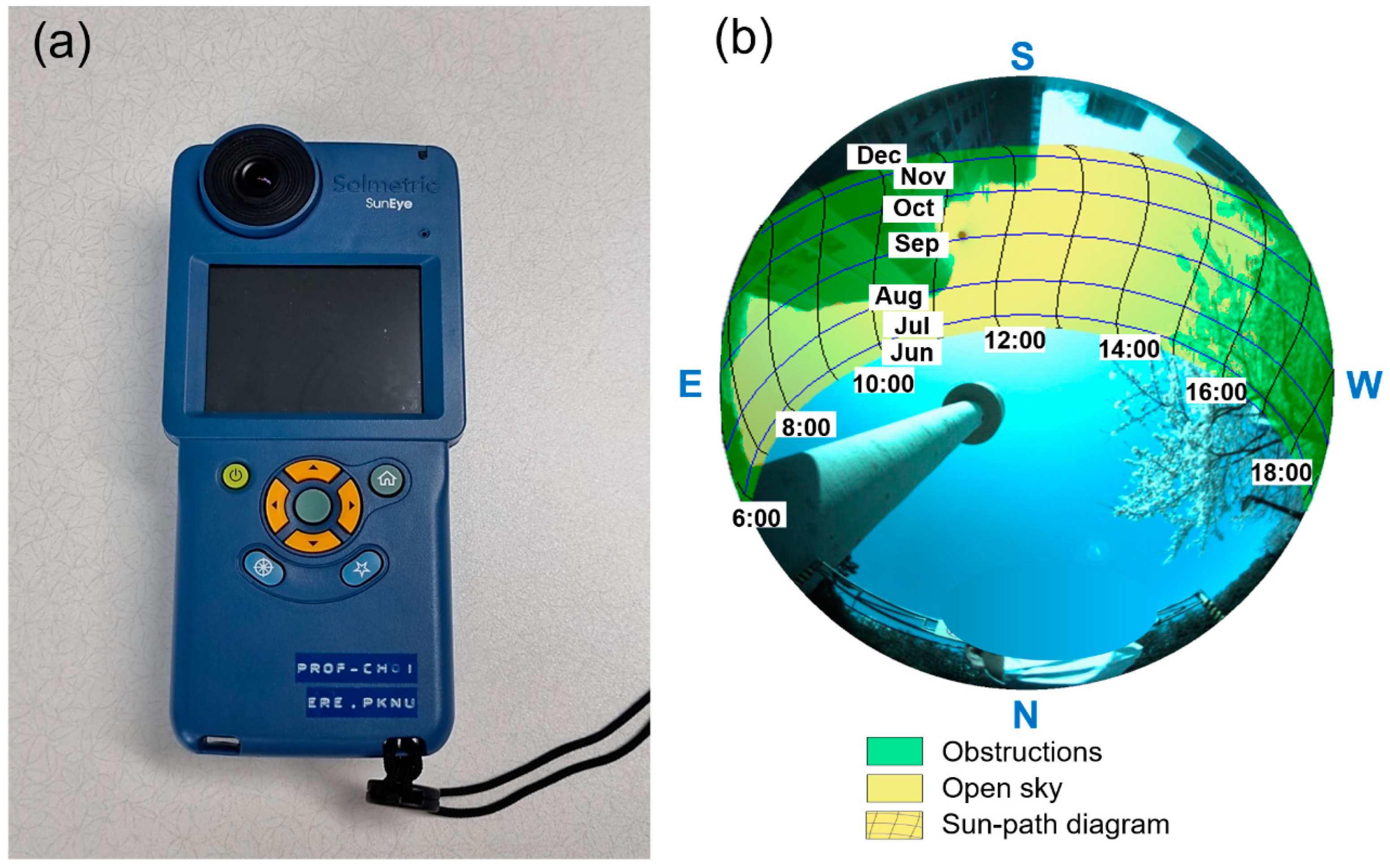
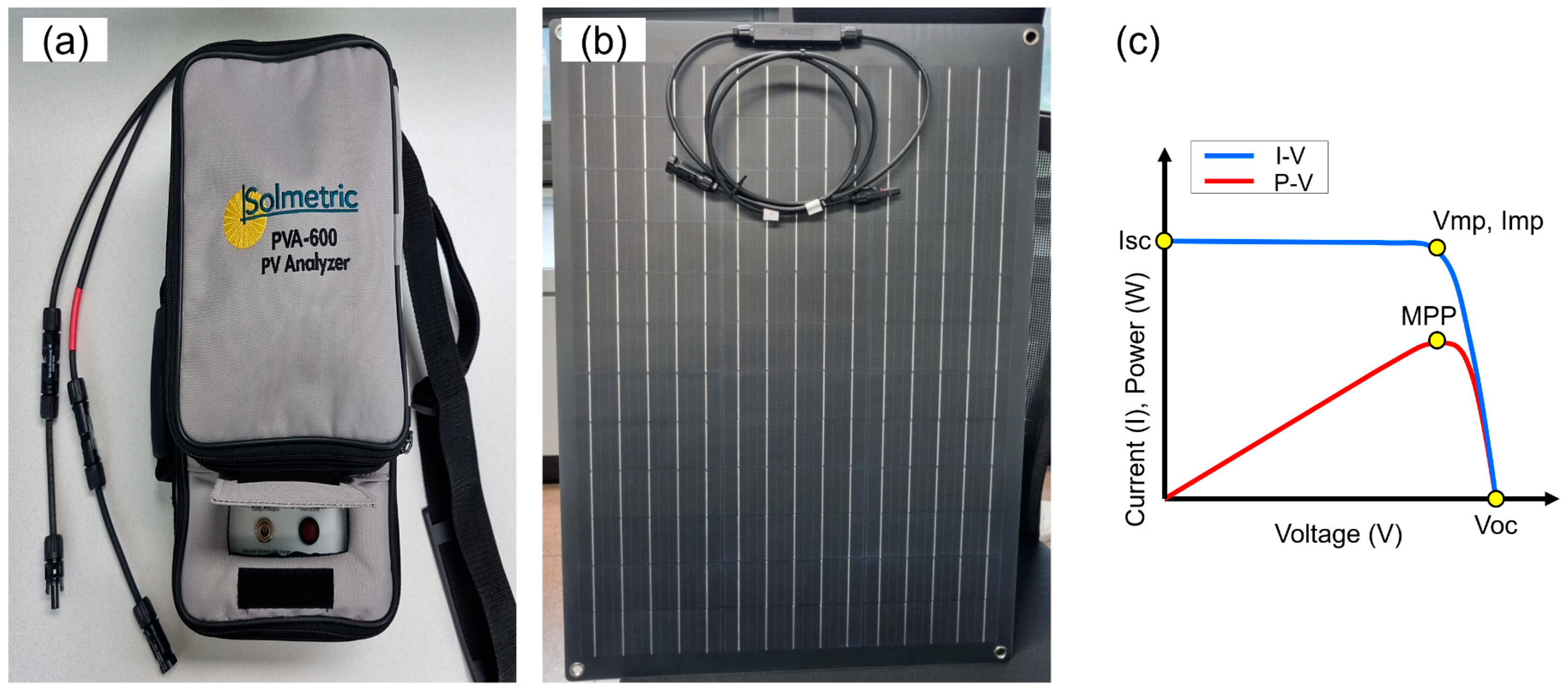
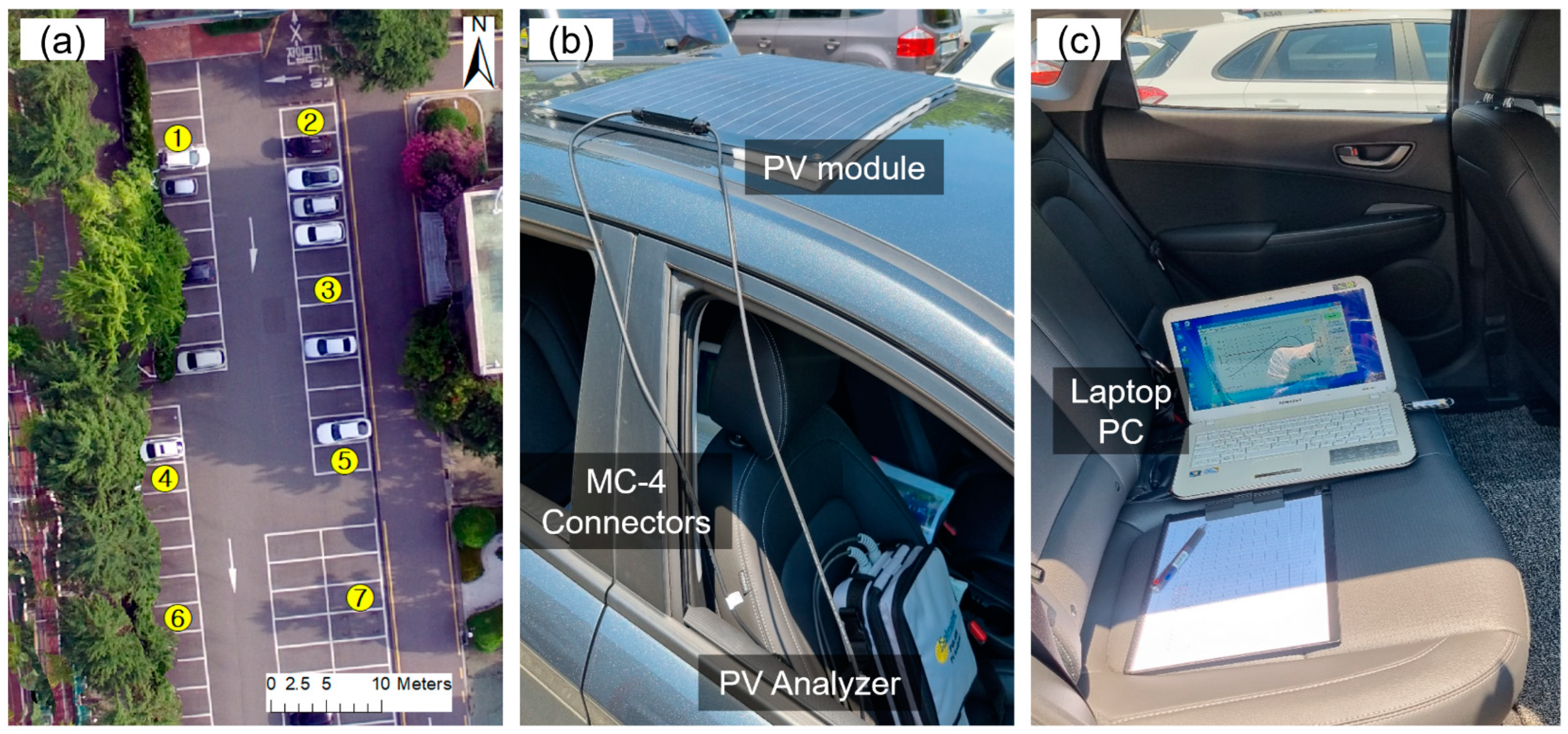
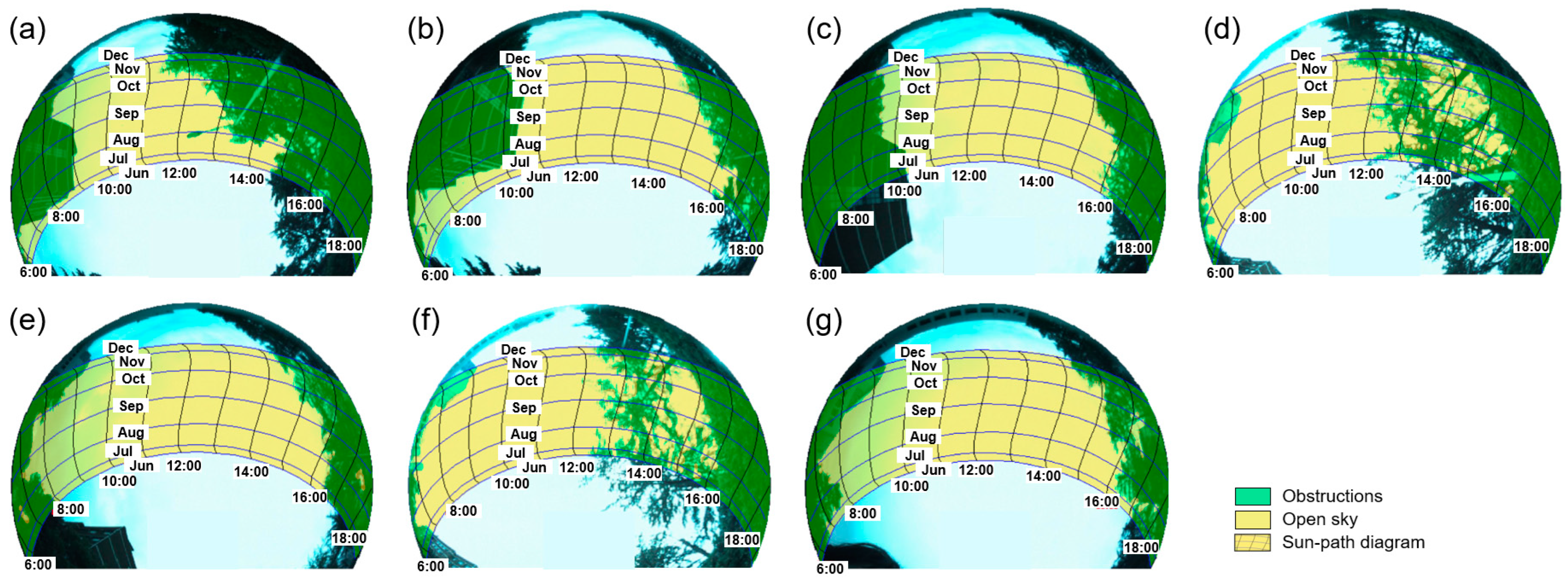
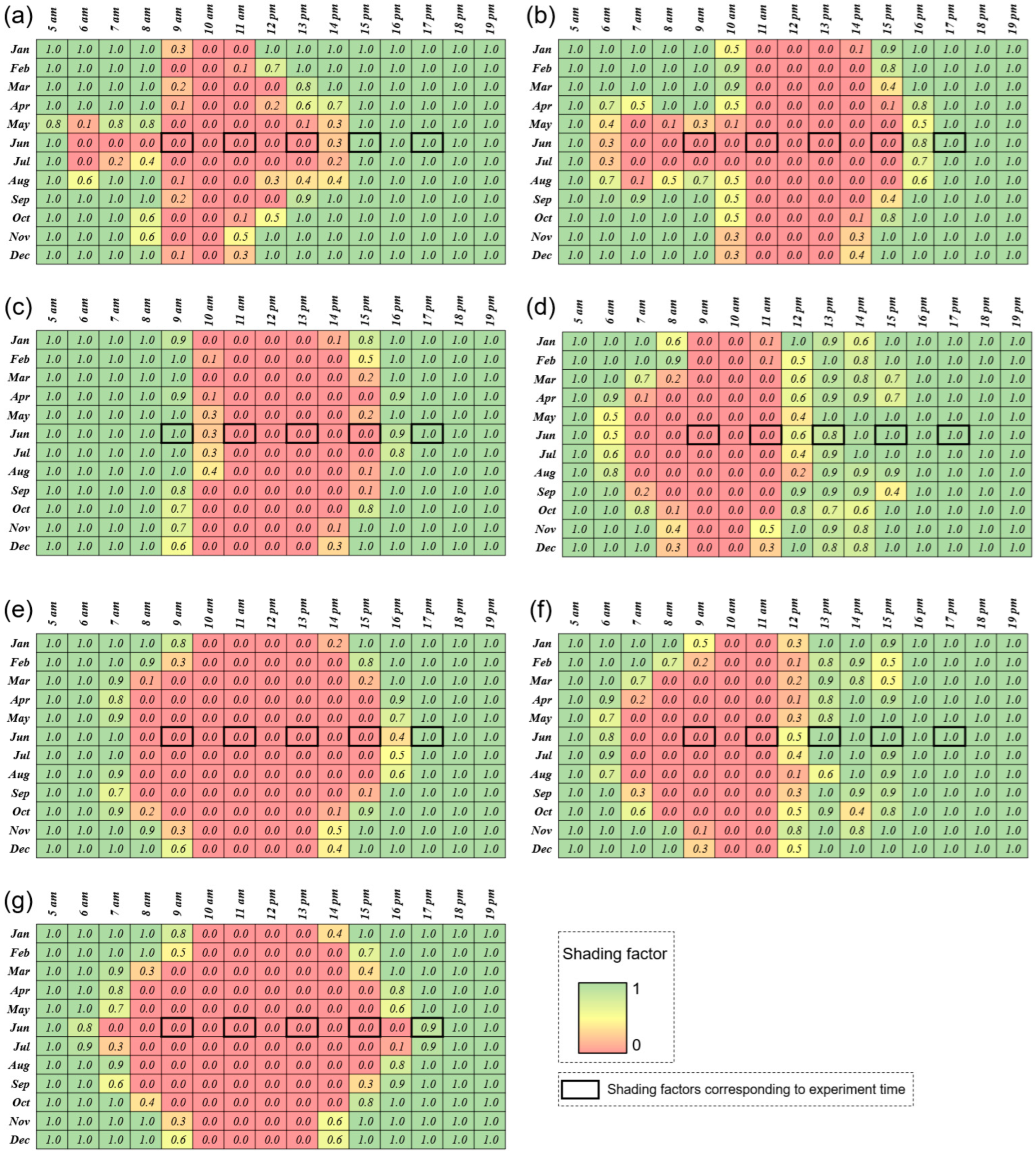

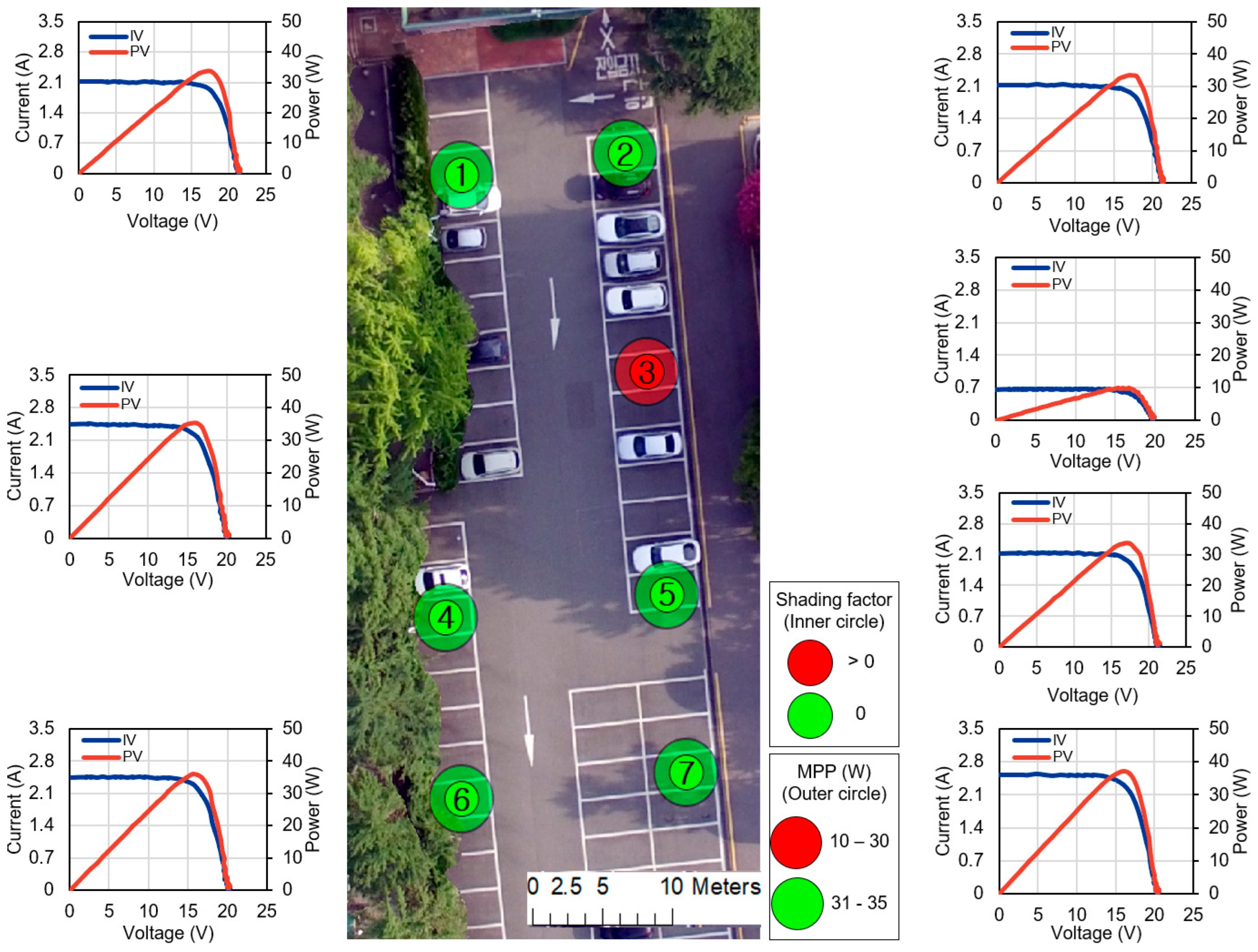
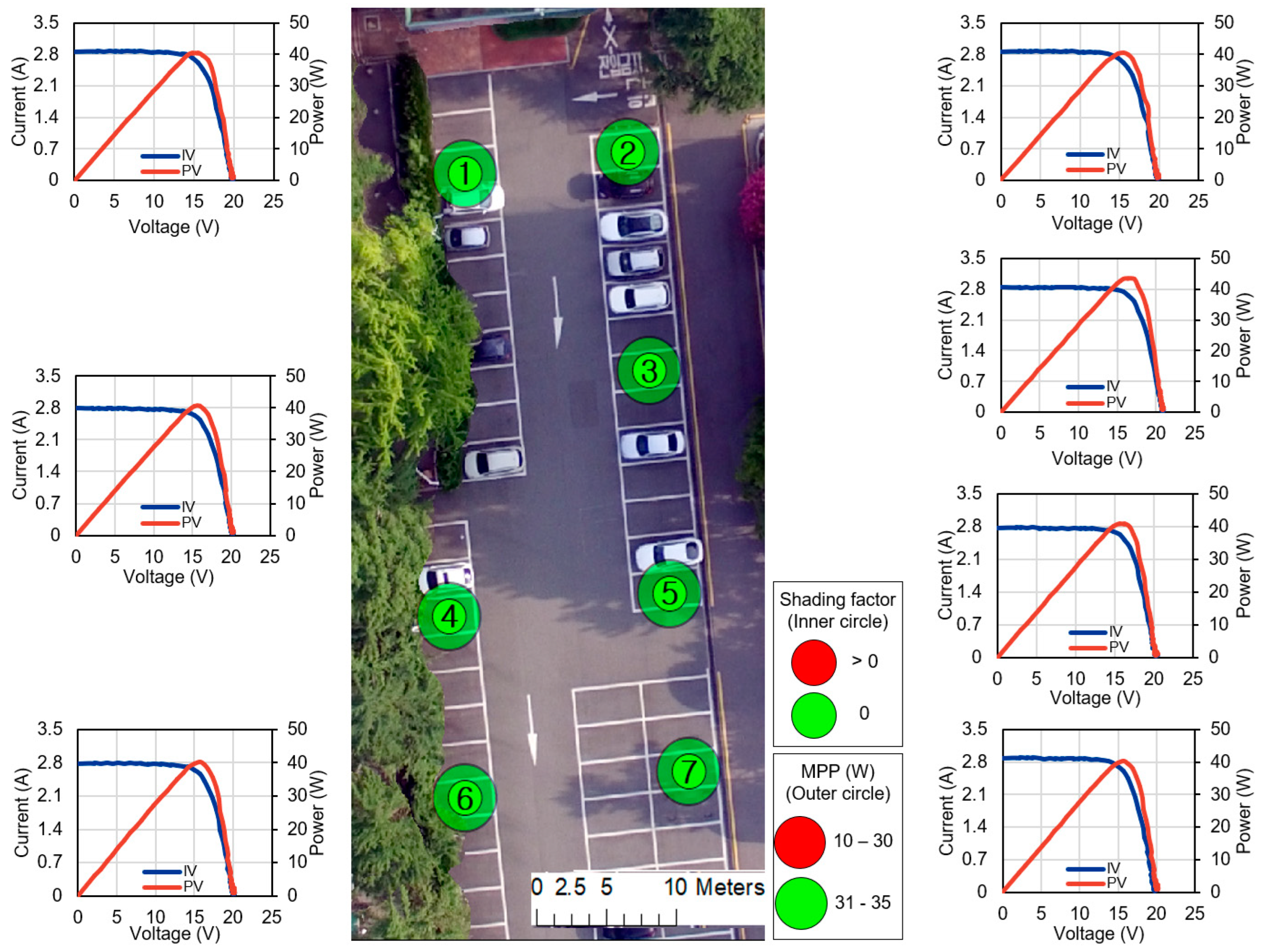
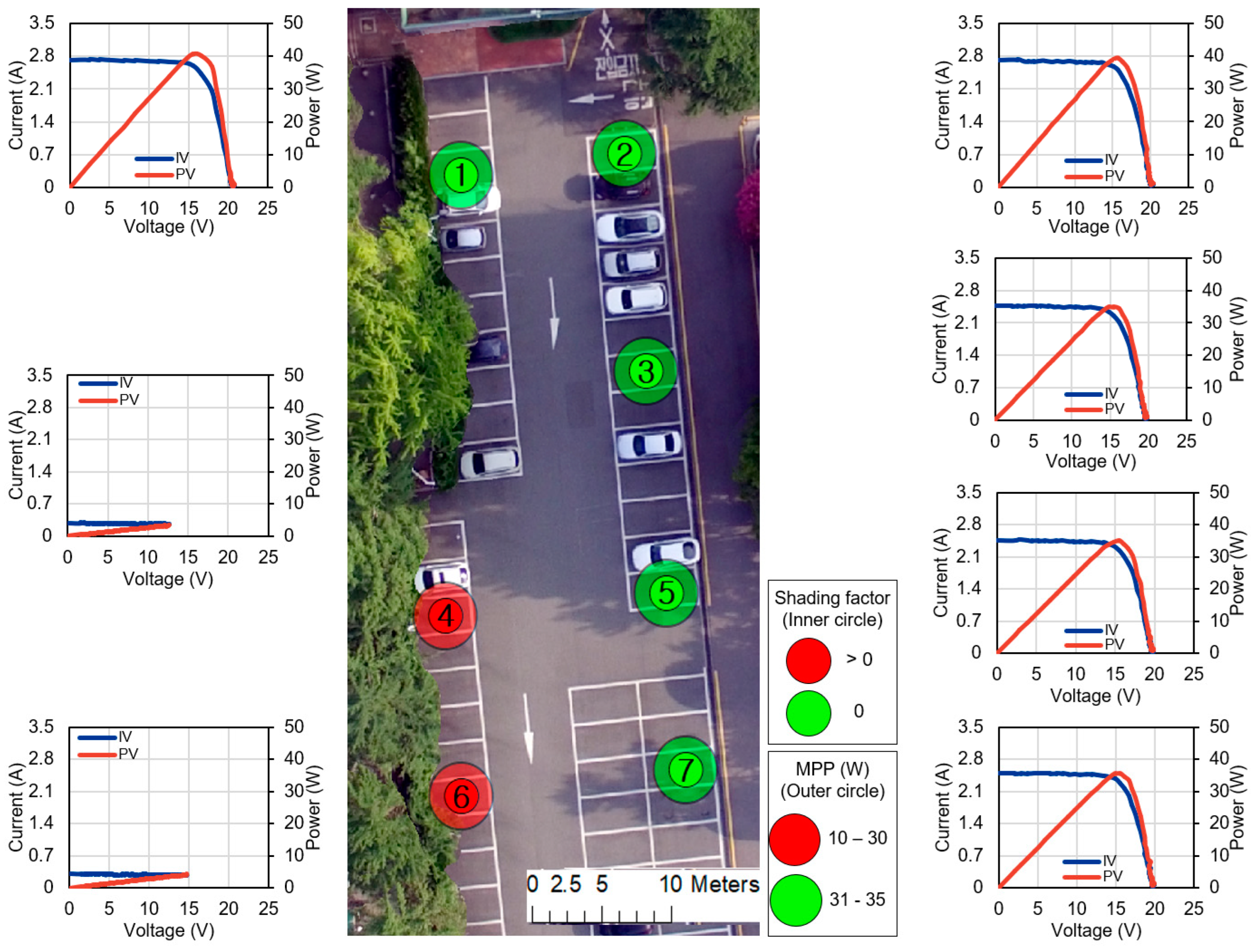

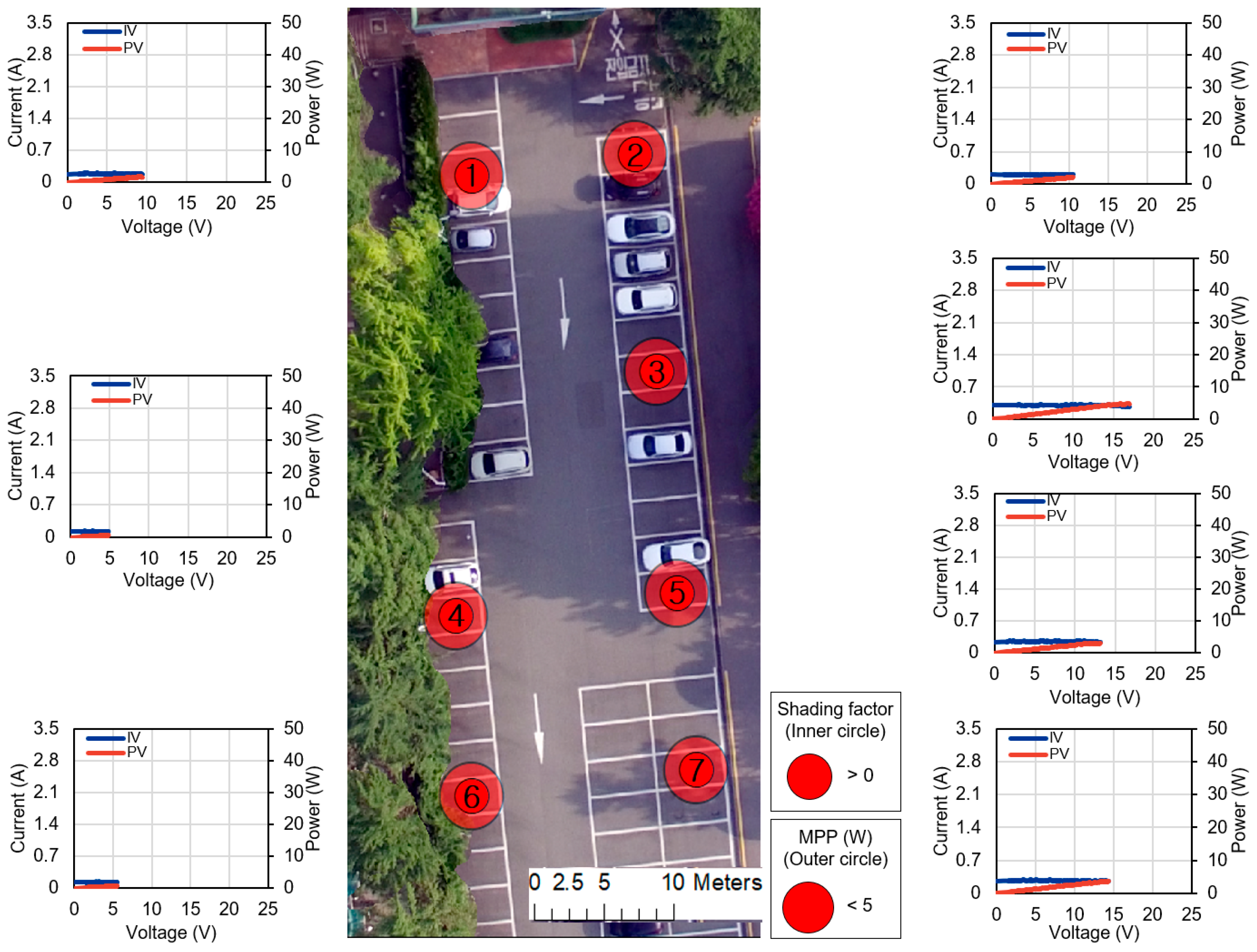
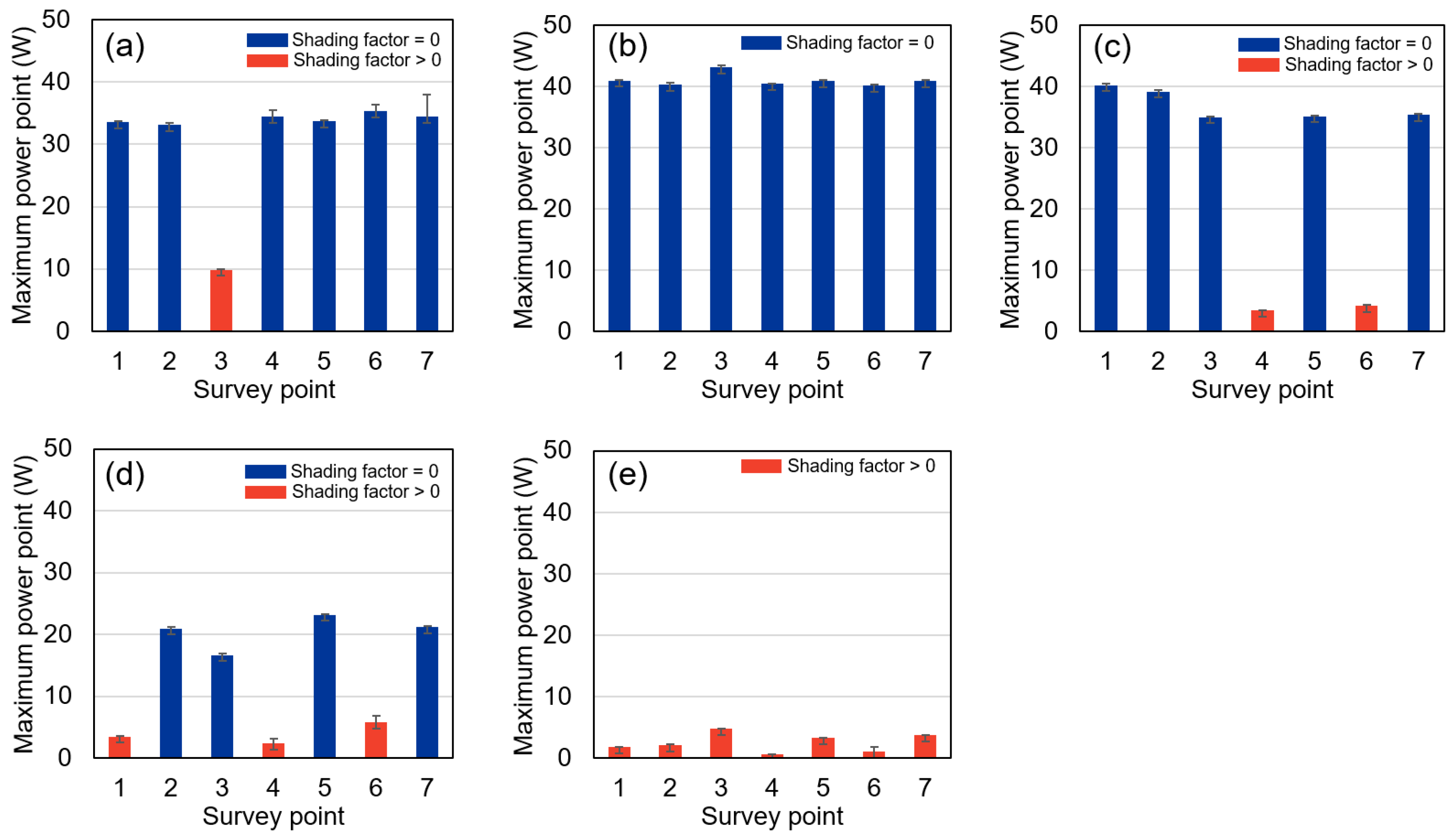
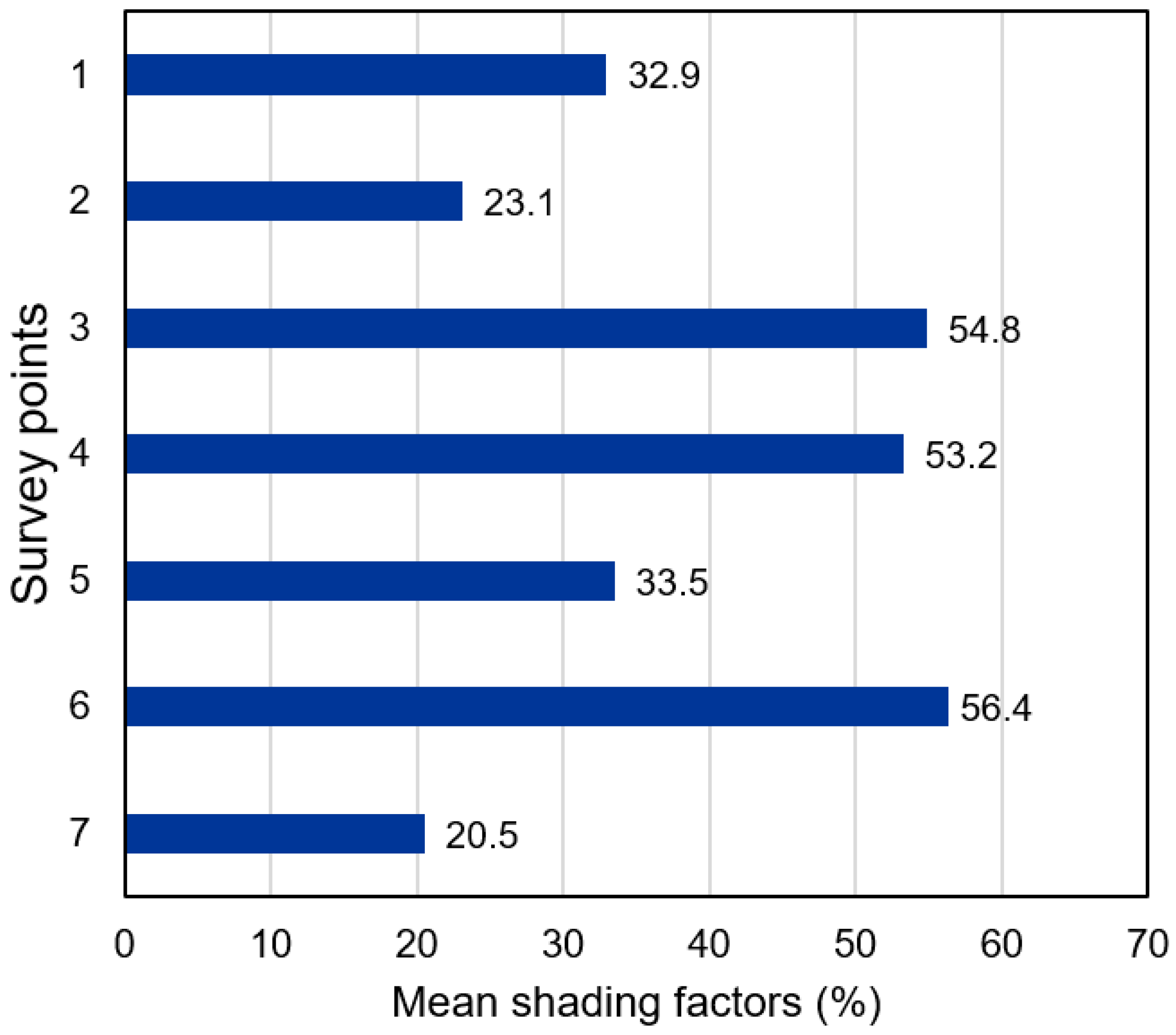
| Parameter | Specification |
|---|---|
| Current measurement range | 0–20 A dc |
| Voltage measurement range (Voc) | 20–600 V dc |
| Load type | Capacitive (3 capacitance values) |
| Measurement sweep time | 50–240 ms |
| Measurement points per trace | 100 |
| Wireless communication range | 10 m |
| Parameter | Specification |
|---|---|
| Model | QH50M-18PP |
| Dimension | 720 × 515 × 2.8 mm |
| Power at the maximum power point (MPP) | 50 W |
| Voltage at the maximum power point (Vmp) | 18 V |
| Current at the maximum power point (Imp) | 2.78 A |
| Open-circuit voltage (Voc) | 21.24 V |
| Short-circuit current (Isc) | 3.06 A |
| Max system voltage | 500 V |
| Test condition | AM = 1.5, E = 1000 W/m2, Tcell = 25 °C |
| Experiment Time | 9 a.m. | 11 a.m. | 13 p.m. | 15 p.m. | 17 p.m. |
|---|---|---|---|---|---|
| Insolation (W/m2) | 261.89 | 750.03 | 721.74 | 453.56 | 125.08 |
| No. of Survey Point | Shading Factor | ||||
|---|---|---|---|---|---|
| 9 a.m. | 11 a.m. | 13 p.m. | 15 p.m. | 17 p.m. | |
| 1 | 0 | 0 | 0 | 1 | 1 |
| 2 | 0 | 0 | 0 | 0 | 1 |
| 3 | 1 | 0 | 0 | 0 | 1 |
| 4 | 0 | 0 | 0.8 | 1 | 1 |
| 5 | 0 | 0 | 0 | 0 | 1 |
| 6 | 0 | 0 | 1 | 1 | 1 |
| 7 | 0 | 0 | 0 | 0 | 0.9 |
Publisher’s Note: MDPI stays neutral with regard to jurisdictional claims in published maps and institutional affiliations. |
© 2022 by the authors. Licensee MDPI, Basel, Switzerland. This article is an open access article distributed under the terms and conditions of the Creative Commons Attribution (CC BY) license (https://creativecommons.org/licenses/by/4.0/).
Share and Cite
Baek, J.; Choi, Y. An Experimental Study on Performance Evaluation of Shading Matrix to Select Optimal Parking Space for Solar-Powered Electric Vehicles. Sustainability 2022, 14, 14922. https://doi.org/10.3390/su142214922
Baek J, Choi Y. An Experimental Study on Performance Evaluation of Shading Matrix to Select Optimal Parking Space for Solar-Powered Electric Vehicles. Sustainability. 2022; 14(22):14922. https://doi.org/10.3390/su142214922
Chicago/Turabian StyleBaek, Jieun, and Yosoon Choi. 2022. "An Experimental Study on Performance Evaluation of Shading Matrix to Select Optimal Parking Space for Solar-Powered Electric Vehicles" Sustainability 14, no. 22: 14922. https://doi.org/10.3390/su142214922






